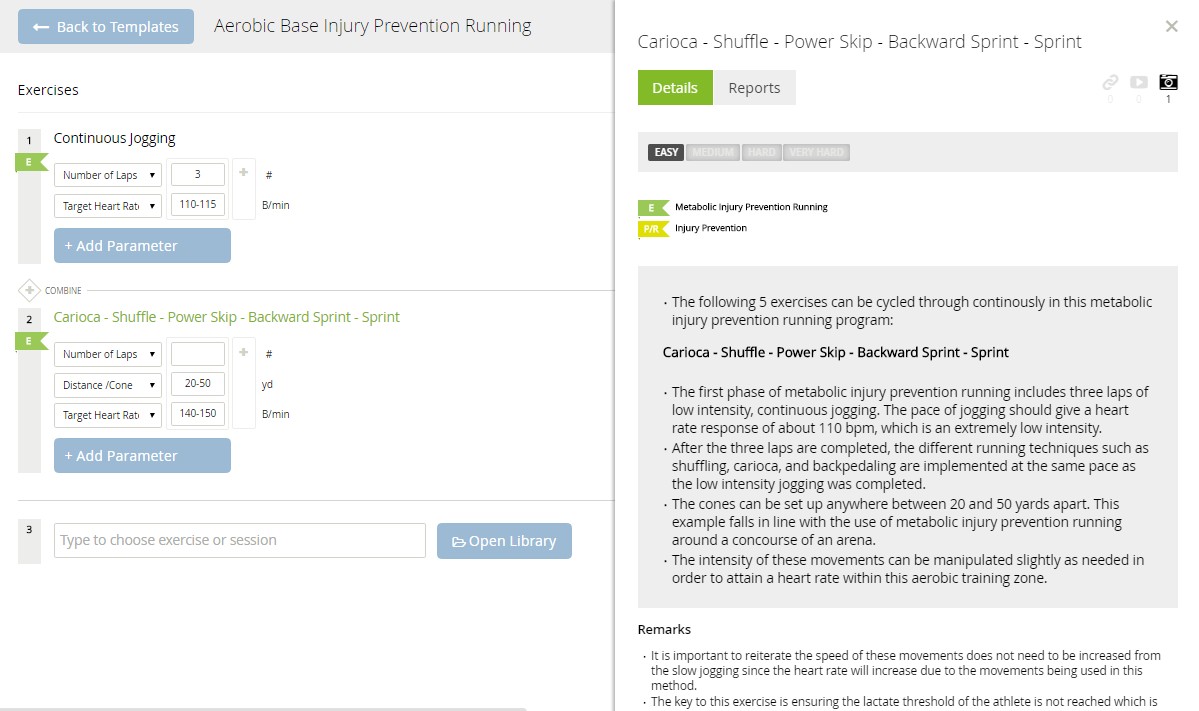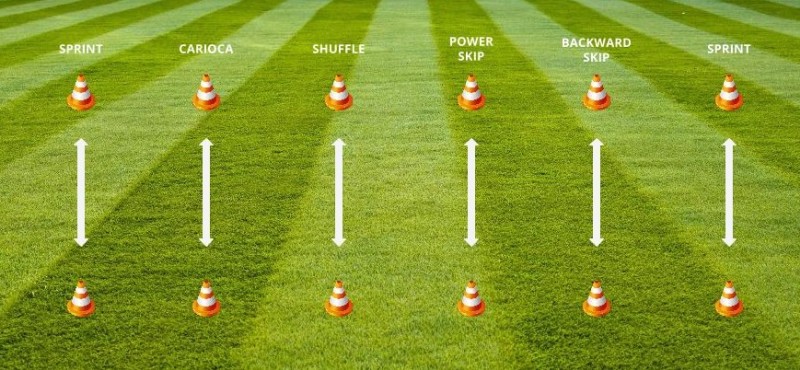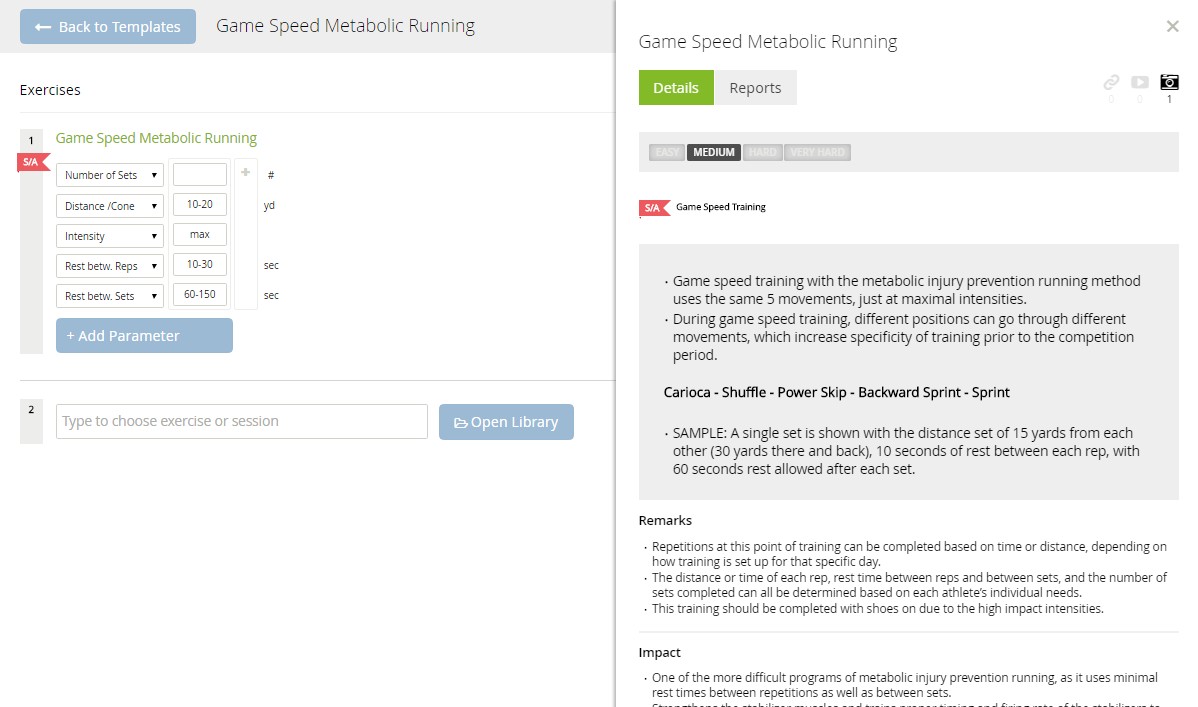This article was originally published on XL Athlete by Matthew Van Dyke and Cal Dietz. With their kind permission we’re sharing it here in a two-part series for Trayn readers. This is part 2 and contains game speed training with an example program and an off-season training distribution. Go here for part 1.
Game Speed Training
As the competition phase approaches and specificity of exercise selection is high, metabolic injury prevention running can be used to peak athletes before the rigors of their long, demanding season.
The stabilizer muscles of the hip, groin, knee, and ankle are continually improved through the same movement patterns as described above, but they are now completed at maximum intensities. These high intensities will drive extremely high levels of cardiovascular fitness, even higher levels of cardiovascular fitness than sprinting, when distance and intensity are compared, as the body is continuing to move using inefficient movements.
This game speed training using the methods of metabolic injury prevention running can be implemented during the final four to five weeks prior to the start of camp or the season and can be individualized based on position to increase specificity. Adaptations from this high-intensity method can be seen in as little as two weeks if an athlete is properly trained throughout the rest of the off-season, meaning they have had adequate aerobic training, as well as high-intensity training.
The more specific movements made to the position and/or movements that will be completed in competition, the greater the benefits will be in injury reduction. This increased specificity leads to training the commonly underused and injury prone stabilizer muscles in the same planes they will be required to be used in competition.
Example Program
The keys of metabolic injury prevention running are the cardiovascular response and the strengthening of the stabilization muscles of the hip, groin, knee, and ankle. The target heart rate zone of this specific aerobic conditioning piece lies within 140-150 bpm.
The first phase of metabolic injury prevention running includes three laps of low intensity, continuous jogging. The pace of jogging should give a heart rate response of about 110 bpm, which is an extremely low intensity.

After the three laps are completed, the different running techniques such as shuffling, carioca, and backpedaling are implemented at the same pace as the low intensity jogging was completed. The inefficiency of the body through these movements will amplify the intensity and spike the heart rate into the goal aerobic heart rate zone of 140-150 bpm while keeping impact intensities low enough to train barefoot, thus strengthening the muscles of the ankle and foot. The intensity of these movements can be manipulated slightly as needed in order to attain a heart rate within this aerobic training zone. It is important to reiterate the speed of these movements does not need to be increased from the slow jogging since the heart rate will increase due to the movements being used in this method.
The example below shows how the five exercises used in this metabolic injury prevention running can be cycled through continuously. The cones can be set up anywhere between 20 and 50 yards apart. The key to this exercise is ensuring the lactate threshold of the athlete is not reached which is why an intensity of 140-150 bpm is set as the goal heart rate range. This method of training can be used with any set-up, even just two cones. This example falls in line with the use of metabolic injury prevention running around a concourse of an arena.

Game speed training with the metabolic injury prevention running method uses the same movements as above, just at maximal intensities. This high-intensity training method strengthens the stabilizer muscles and trains proper timing and firing rate of the stabilizers to prevent injury during competition. During game speed training, different positions can go through different movements, which increase specificity of training prior to the competition period. It should be noted this training should be completed with shoes on due to the high impact intensities.
The example of game speed training below shows the progression through this phase of training. Repetitions at this point of training can be completed based on time or distance, depending on how training is set up for that specific day. The same movements will be used during this progression, but will be completed at maximum velocities.

The distance or time of each rep, rest time between reps and between sets, and the number of sets completed can all be determined based on each athlete’s individual needs to prepare them for a successful camp and/or season. In the example below, a single set is shown with the distance set of 15 yards from each other (30 yards there and back), 10 seconds of rest between each rep, with 60 seconds rest allowed after each set. The example shown is one of the more difficult programs of metabolic injury prevention running, as it uses minimal rest times between repetitions as well as between sets.

Off Season
The off-season can be broken into 3 phases of conditioning training as follows.
Phase 1
During this phase, base running and training are completed. This is the phase in which metabolic injury prevention running will be completed. This first phase of training typically lasts between 2 and 4 weeks, with the goal of creating a solid foundation of training which will allow more intense training as the off-season progresses. Metabolic injury prevention running can be completed between 2 and 3 times per week due to its low impact intensities and overall lower intensity on the body.
Phase 2
Phase 2 consists of sport specific speed development and includes the qualities of acceleration, top end speed, and change of directions. The majority of the time within this phase will be spent completing as many sport specific drills as possible. This intermediate phase will last between 4 and 8 weeks to allow optimal development, with high quality work being the goal of each repetition.
Phase 3
This final phase of the off-season periodization consists of game speed conditioning. This will be completed 2 to 3 weeks prior to the beginning of training camp or the season. This phase is used as the final peaking method to prepare athletes for camp or an athlete’s season. It will offer optimal conditioning and injury prevention using maximal intensities. It should be performed at least twice a week, if not three times, when no other conditioning methods are being utilized. However, if speed development of athletes is still required, this quality can be trained throughout the week.
This concludes our two-part series on metabolic injury prevention running. If you haven’t read it yet, go here to read part 1.
About the authors
Matthew Van Dyke is an Assistant Strength and Conditioning Coach at the University of Denver. At Denver, Matt is responsible for designing and implementing speed, strength, conditioning, and mobility workouts for men’s lacrosse, alpine ski, volleyball, tennis and swimming.
Cal Dietz is a Sports Performance Coach at the University of Minnesota, Co-Author of Triphasic Training, and owner of XL Athlete. During his tenure, Dietz has trained: a Hobey Baker Award winner, two Big Ten Athletes of the Year, athletes that have achieved 375 All-American honors, 24 Big Ten/WCHA championships teams and 7 NCAA Team Champions, and 13 teams finish in the top four in the nation. He has consulted with Olympic and World Champions in various sports and professional athletes in the NHL, NFL, NBA, MLB, and Professional Boxing.

